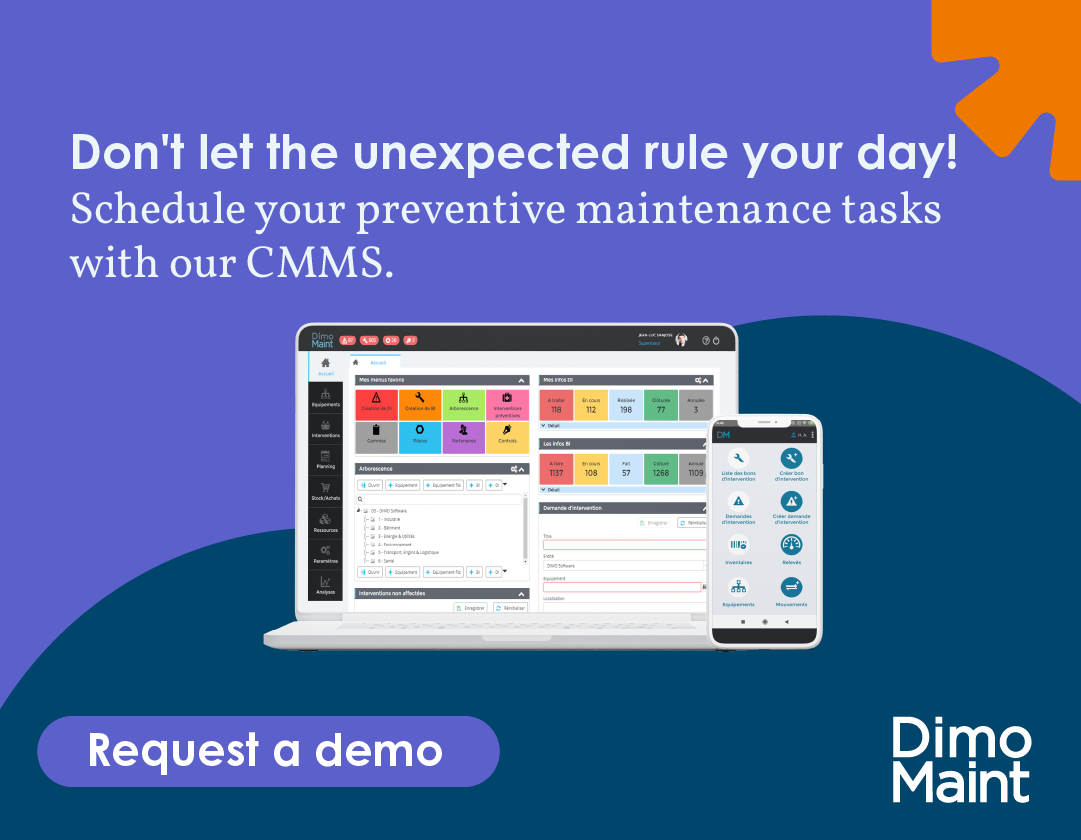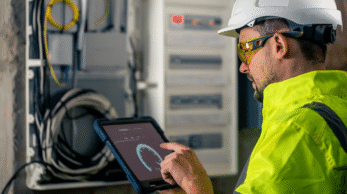Machine Learning is no longer experimental. It is gradually integrating into advanced maintenance tools, particularly to anticipate failures. Before delving into the technical aspects, it is essential to understand what this technology enables in an industrial environment and how it fits into a broader approach to predictive maintenance.
What is the potential of Machine Learning for maintenance
A data-driven predictive approach
Unlike traditional approaches—corrective, preventive, or even conditional maintenance—Machine Learning allows action before visible signs of wear or degradation appear. While conditional maintenance relies on simple physical thresholds (temperature, vibration, pressure…), ML relies on complex correlations learned from millions of lines of collected data.
This analytical capability is based on operating histories, machine usage cycles, past alerts, and environmental data. The trained statistical model does not wait for the value to exceed a limit; it anticipates an abnormal trajectory.
Anomaly detection vs. failure prediction: two often confused approaches.
- Anomaly detection involves identifying unusual behavior compared to normal operation (atypical value, inconsistent sequence). It signals a deviation but says nothing about its impact or evolution.
- Failure prediction, on the other hand, models the probability of a critical event (breakdown, rupture, stoppage) occurring based on trends, usage contexts, and past examples. It projects over time, with a notion of severity.
An effective model for predictive maintenance often combines both: anomalies to alert early, prediction to prioritize.
What ML can (and cannot) do
ML does not just trigger an alarm in case of a punctual deviation. It can identify a slow and gradual drift, imperceptible to the human eye or set thresholds. For example, a slight cyclical increase in engine temperature, which never crosses the alert limit, can be interpreted as the beginning of misalignment. This type of weak signal is typically what ML learns to recognize.
However, it is not a universal solution. ML is only relevant if the quality and quantity of data are sufficient. It cannot “invent” a failure pattern if the machine is new, if sensors are absent or poorly calibrated, or if the usage environment is too variable and poorly described.
A shift in posture for maintenance teams
What Machine Learning profoundly changes is not just data processing but the very approach to maintenance. It is no longer about intervening when a symptom appears but about detecting abnormal behaviors before a symptom is even visible. This requires teams to move away from a fixed threshold logic to adopt a dynamic reading of assets, often coupled with visual interfaces or decision-support tools. It also requires closer collaboration between operational roles and data analysts, as the model is only valuable if understood and validated in the field.
A technology serving industrial strategy
In many industries (petrochemical, rail, food), the challenge is no longer just to optimize asset availability but to ensure their long-term integrity. Machine Learning finds its place when it allows extending maintenance intervals, better prioritizing interventions, or planning technical shutdowns at the most opportune time.
How AI learns to recognize weak signs of failure
AI, and more specifically Machine Learning, transforms how maintenance managers detect failures. Far from being limited to alerts based on fixed thresholds, AI processes complex data sets to spot subtle anomalies, invisible to the naked eye.
Supervised learning: teaching AI to recognize failures
With supervised learning, AI is trained on historical failure data, allowing it to associate specific data patterns with failure events.
Unsupervised learning: detecting anomalies without labels
Unsupervised learning is particularly useful in environments where failure data is scarce. In this case, the algorithm identifies unusual behaviors without needing labeled data, enabling early detection.
Reinforcement learning: optimizing maintenance decisions
Reinforcement learning, although less commonly used, offers great potential. By simulating different maintenance scenarios, it helps AI make optimal decisions to reduce costs and improve intervention efficiency.
The challenges of machine learning in maintenance
Despite its advantages, integrating AI in maintenance presents challenges. Data quality is paramount: poorly calibrated sensors or incomplete data can impair model performance. Additionally, model interpretability is essential for maintenance teams to trust them. Finally, collaboration between domain experts and data scientists is crucial to adapt solutions to the specificities of each industrial environment.
Thus, AI does not just signal anomalies; it learns to understand the subtleties of asset behavior, enabling more precise failure anticipation.
For which sectors and actors is Machine Learning becoming relevant in maintenance?
Machine Learning is particularly relevant in environments where reliability is paramount and downtime costs are high. Here are some examples:
- Rail: Companies like KONUX develop predictive maintenance systems to monitor the condition of switches and tracks, reducing unexpected failures.
- Energy: Shell and SSE use AI to monitor critical infrastructure and plan maintenance proactively.
- Aerospace: Qantas applies AI to adjust flight routes based on weather conditions and aircraft capabilities, optimizing fuel consumption and maintenance planning.
- Manufacturing: Companies like Coca-Cola and Siemens Energy integrate AI-powered platforms to optimize their maintenance operations.
- Urban transport: In Barcelona, the Bicing system uses predictive maintenance models to anticipate bike maintenance, improving availability and safety.
These examples show the diversity of sectors where Machine Learning plays a key role in maintenance.
How to succeed in your Machine Learning project in maintenance: the roadmap
Implementing a predictive maintenance project based on Machine Learning requires a methodical and progressive approach. Here are the key steps to ensure the success of this transition to proactive maintenance, while integrating suitable tools, such as a CMMS (Computerized Maintenance Management System).
- Initial assessment and objective definition
Start by identifying critical assets and specific challenges in your environment. This phase helps define priorities: reducing costs, increasing asset availability, or improving safety. A thorough needs analysis will guide the choice of technologies and methods to adopt, including the implementation or integration of a suitable CMMS for tracking interventions and maintenance data. - Data collection and preparation
Data quality is essential for the success of an ML project. Install IoT sensors to collect information on parameters such as temperature, vibration, or pressure. These data must then be cleaned, normalized, and centralized on a platform, often cloud-based. Integrating a CMMS at this stage allows centralizing not only machine data but also intervention histories, maintenance reports, and schedules, facilitating analysis and decision-making. - Model selection and development
Depending on the complexity of the assets and expected failures, several Machine Learning models can be considered:- Supervised learning: useful when labeled data is available, to predict failures based on past behaviors.
- Unsupervised learning: to detect anomalies without labeled data, identifying unusual behaviors.
- Reinforcement learning: optimizing maintenance strategies by simulating interventions and measuring their impact.
The CMMS plays a key role by documenting maintenance decisions made, recording intervention results, and synchronizing these actions with AI models in real-time.
- Validation and deployment
Before large-scale production, it is advisable to conduct a pilot project on an asset or a small group of assets. This phase allows testing prediction accuracy and validating models. Integrating a CMMS at this stage ensures smooth management of maintenance tasks and guarantees traceability of interventions carried out within the pilot project. - Monitoring, maintenance, and continuous improvement
Once models are deployed, it is crucial to continuously monitor their performance. The CMMS becomes an indispensable tool for this phase, as it allows real-time feedback collection and model adjustment based on new data collected. Regular model updates and parameter adjustments based on real data will ensure the sustainability and effectiveness of the predictive maintenance system. - Organizational culture and training
The success of the project does not rely solely on technology but also on people. It is therefore essential to train maintenance teams in using new tools, particularly the CMMS, so they can fully leverage the system’s features. Promoting a culture of collaboration between domain experts and data scientists will foster acceptance of new methods and optimize their impact on overall performance.
Machine Learning allows detecting and anticipating failures before they occur. By integrating this technology with tools like CMMS, companies can not only improve asset availability but also optimize their maintenance strategies. The key to success lies in data quality, collaboration between technical teams and data scientists, and adopting a proactive and structured approach.







